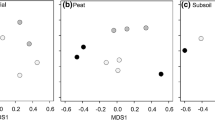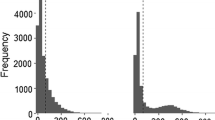Abstract
The community of indigenous mycorrhizal fungi on planted-out nursery seedlings of Scots pine (Pinus sylvestris L.) was surveyed for two years at two sites in Sweden. Factors studied were the effect of forests versus clearcuts on these communities, age of clearcut, planting-out in early summer versus autumn, age of planted-out seedlings and time of soil scarification. Analyses of variance and detrended correspondence analysis showed that the relative magnitude of the effects of these factors upon the composition of the ectomycorrhizal community on seedlings planted out was site > time of outplanting > forest/clearcut > age of clearcut > time of soil scarification. In general, clear-cutting had a minor effect, both qualitatively and quantitatively. Nineteen different mycorrhizal types were recorded. After two seasons, seedlings hosted an average of 1.8 indigenous mycorrhizal types and 0.95 nursery mycorrhizal types comprising 35% and 65% of the mycorrhizal roots, respectively.Piloderma croceum colonized seedlings significantly more frequently in forests than in clearcuts, whereas the reverse was found forCenococcum geophilum, and two other mycorrhizal types. However, there is a general agreement between mature coniferous forests and clearcuts as regards both the inoculum potential of dominant fungi adapted to early colonization, and the composition of these fungal species. The fungal adaptations to forests obviously resemble those conditions occurring at clearcuts.
Similar content being viewed by others
References
Agerer R 1986 Studies on ectomycorrhizae. II. Introducing remarks on characterization and identification. Mycotaxon. 26, 473–492.
Agerer R 1988 Colour Atlas of Ectomycorrhizae. Einhorn-Verlag Eduard Dietenberger, München
Arnebrant K and Söderström B 1990 The influence of ectomycorrhizal mycelial colonization and infection. Agric. Ecosystems Environ. 28, 21–25.
Castellano M A and Molina R 1989 Mycorrhizae.In The Container Tree Nursery Manual, Vol. 5, Eds. T D Landis, R W Tinus, S E McDonald and J P Barnett. pp 101–167. Agric. Handbk. 674, Washington, DC.
Christy E J, Sollins P and Trappe J M 1982 First-year survival ofTsuga heterophylla without mycorrhiza and subsequent ectomycorrhizal development on decaying logs and mineral soil. Can. J. Bot. 60, 1601–1605.
Dahlberg A 1990 Effect of soil humus cover on the establishment and development of mycorrhizae on containerizedPinus sylvestris L. andPinus contorta ssp.latifolia engelm. after outplanting. Scand. J. For. Res. 5, 103–112.
Dahlberg A and Stenlid J 1990 Population structure and dynamics inSuillus bovinus as indicated by spatial distribution of fungal clones. New Phytol. 115, 487–493.
Danielson R M and Pruden M 1989 The ectomycorrhizal status of urban spruce. Mycologia 81, 335–341.
Danielson R M and Visser S 1989a Host response to inoculation and behaviour of introduced and indigenous ectomycorrhizal fungi of jack pine grown on oil-sands tailings. Can. J. For. Res. 19, 1412–1421.
Danielson R M and Visser S 1989b Effects of forest soil acidification on ectomycorrhizal and vesicular-arbuscular mycorrhizal development. New Phytol. 112, 41–47.
Diggle P J, Besag J and Gleaves J T 1976 Statistical analysis of spatial point patterns by means of distance methods. Biometrics 32, 659–667.
Eriksson J, Hjortstam K and Ryvarden I 1981 The Corticiaceae of North Europe. Vol. 6. Phlebia-Sarcodontia, Fungiflora. Oslo.
Ferrier R C and Alexander I J 1985 Persistence under field conditions of excised fine roots and mycorrhizas of spruce.In Ecological Interactions in Soil. Eds. A H Fitter, D Atkinson, D J Read and M B Usher. pp 175–179. Blackwell Scientific Publications, Oxford.
Fox F M 1986a Ultrastructure and infectivity of schlerotiumlike bodies of the ectomycorrhizal fungusHebeloma sacchariolens, on birch (Betula spp.). Trans. Br. Mycol. Soc. 87, 359–369.
Fox F M 1986b Notes and brief articles: Ultrastructure and infectivity of sclerotia of the ectomycorrhizal fungusPaxillus involutus on birch (Betula spp.) Trans. Br. Mycol. Soc. 87, 627–658.
Frankland J C and Harrison A F 1985 Mycorrhizal infection ofBetula pendula andAcer pseudoplatanus: Relationship with seedling growth and soil factors. New Phytol. 101, 133–151.
Harley J L and Smith S E 1983 Mycorrhizal Symbiosis. Academic Press, London. 483 p.
Harvey A E, Larsen M J and Jurgensen M F 1976 Distribution of ectomycorrhizae in a mature Douglas-fir/larch forest soil in western Montana. Forest Sci. 22, 393–398.
haselwandter K, Bobleter O and Read D J 1990 Degradation of14C-labelled lignin and dehydropolymer of coniferyl alcohol by ericoid and ectomycorrhizal fungi. Arch. Microbiol. 153, 352–354.
Hägglund B 1974 Site index curves for Scots pine in Sweden. Inst. för skogsproduktion, Skogshögskolan (Stockholm). Rapporter och uppsatser No. 31, 54 p.
Jansen A E and de Vries F W 1988 Dutch priority programme on acidification. Qualitative and quantitative research on the relation between ectomycorrhiza ofPseudotsuga menziesii, vitality of the host and acid rain. Report 25-02. CEC Research contract ENV-896-NL. Comm. no. 373 of the Biological Station, Wijster, The Netherlands.
Kielland-Lund J 1973 A classification of Scandinavian forest for mapping purposes.In IBP i Norden 11, 173–206.
Laiho O 1970Paxillus involutus as a mycorrhizal symbiont of forest trees. Acta For. Fenn. 79, 1–35.
Lamb R J 1979 Factors responsible for the distribution of mycorrhizal fungi of Pinus in eastern Australia. Aust. For. Res. 9, 25–34.
Lehto T 1989 Mycorrhizal status of Scots pine nursery stock in Finland. Folia Foretalia. 726, 15 p.
Maser C, Trappe J M and Nussbaum R A 1978 Fungal-small mammal interrelationship with emphasis on Oregon coniferous forests. Ecology 59, 799–809.
Mason P A, Last F T, Wilson J, Deacon J W, Fleming L V and Fox F M 1987 Fruiting and successions of ectomycorrhizal fungi.In Fungal Infection of Plants. Eds. G F Pegg and P G Ayres. pp 253–268. Cambridge University Press, Cambridge.
Menge J A and Grand L F 1978 Effect of fertilization on production of epigeous basidiocarps by mycorrhizal fungi in loblolly pine plantations. Can. J. Bot. 56, 2357–2362.
Mikola P 1973 Application of mycorrhizal symbiosis in forestry practice.In Ectomycorrhizae—Their Ecology and Physiology. Eds. G C Marks and T T Kozlowski. pp 383–411. Academic Press, New York.
Mikola P and Laiho O 1962 Mycorrhizal relations in the raw humus layer of northern spruce forests. Communicationes Instituti Forestalis Fenniae. Helsinki 55, 1–13.
Mikola P, Hahl J and Torniainen E 1966 Vertical distribution of mycorrhizae in pine forest with spruce undergrowth. Ann. Bot. Fenn. 3, 406–409.
Molina R and Trappe J 1982 Lack of mycorrhizal specificity by the ericaceousArbutus menziessi andArctostaphylos uva-ursi. New Phytol. 90, 495–509.
Peet R K, Knox R G, Case J S and Allen R B 1988 Putting things in order: The advantages of detrended correspondence analysis. Am. Nat. 131, 924–934.
Perry D A, Mayer M M, Egeland D, Rose S L and Pilz D 1982 Seedling growth and mycorrhizal formation in clearcut and adjacent, undisturbed soils in Montana: A greenhouse bioassay. Forest Ecology and Management 4, 261–273.
Perry D A, Molina R and Amaranthus M P 1987 Mycorrhizae, mycorrhizospheres, and reforestation: Current knowledge and research needs. Can. J. For. Res. 17, 929–940.
Persson H 1982 Changes in the tree and dwarf shrub fineroots after clearcutting in a mature Scots pine stand. Technical Report 31, Swedish Coniferous Forest Project/Department of Systems Ecology. Swedish University of Agricultural Sciences. 18 p.
Pilz D P and Perry D A 1984 Impact of clearcut and slash burning on ectomycorrhizal associations of Douglas-fir seedlings. Can. J. For. Res. 14, 94–100.
Rayner A D M and Boddy L 1988 Fungal Decomposition of Wood—Its Biology and Ecology. Wiley, Chichester. 287 p.
Read D J, Francis R and Finlay R D 1985 Mycorrhizal mycelia and nutrient cycling in plant communities.In Ecological Interactions in Soil. Eds. A H Fitter, D Atkinson, D J Read and M B Usher, pp 193–217. Blackwell Scientific Publications, London.
Robertson N F 1954. Studies on the mycorrhiza ofPinus sylvestris. I. The pattern and development of mycorrhizal roots and its significance for experimental studies. New Phytol. 53, 253–283.
Sen R 1990 Intraspecific variation in two species ofSuillus from Scots pint (Pinus sylvestris L.) forests based on somatic incompatibility and isoenzyme analyses. New Phytol. 114, 607–616.
Shaw III C G and Sidle R C 1983 Evaluation of planting sites common to a southeast Alaska clearcut. II. Available inoculum of the ectomycorrhizal fungusCenococcum geophilum. Can. J. For. Res. 13, 9–11.
Sinclair W A and Marx D H 1982 Evaluation of plant response to inoculation—A. Host variables.In Methods and Principles of Mycorrhizal Research. Ed. N C Schenk. pp 165–174. The Am. Phytopath. Soc., St. Paul, MN.
Stenström E and Ek M 1990 Field growth ofPinus sylvestris following nursery inoculation with mycorrhizal fungi. Can. J. For. Res. 20, 914–918.
Swedish Meterological and Hydrological Institute 1988 Väder och vatten, väderåret 1987.
Tayler A F S and Alexander I J 1991 Ectomycorrhizal synthesis withTylospora fibrillosa, a member of theCorticiaceae. Mycol. Res. 95, 381–384.
Ter Brak C F J and Prentice I C 1988 A theory of gradient analysis. Adv. Ecol. Res. 18, 271–317.
Trappe J M 1964 Mycorrhizal hosts and distribution ofCenococcum graniforme. Lloydia 27, 100–107.
Väre H 1989 The mycorrhizal condition of weakened Scots pine saplings grown on ploughed sites in northern Finland. Can. J. For. Res. 19, 341–346.
Vogt K A, Edmonds R L and Grier C C 1981 Seasonal changes in biomass and vertical distribution inAbies amabilis stands: The role ofCenococcum graniforme. Holarctic Ecol. 4, 1–8.
Author information
Authors and Affiliations
Rights and permissions
About this article
Cite this article
Dahlberg, A., Stenström, E. Dynamic changes in nursery and indigenous mycorrhiza ofPinus sylvestris seedlings planted out in forest and clearcuts. Plant Soil 136, 73–86 (1991). https://doi.org/10.1007/BF02465222
Received:
Revised:
Issue Date:
DOI: https://doi.org/10.1007/BF02465222




